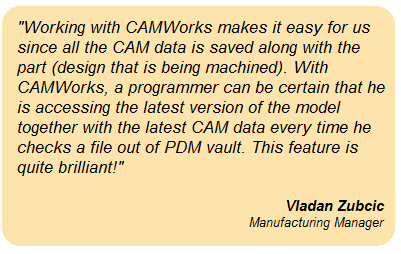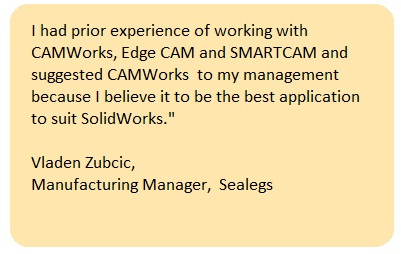Sealegs: On a smooth sail with CAMWorks Back to Customer Success
The Client
The world’s largest manufacturer of amphibious boats, New Zealand-based Sealegs International manufactures recreational and rescue crafts that can be driven in and out of water. Using the company’s proprietary technology, motorized, retractable and steerable wheels are fitted to specially designed power boats, which when approaching land, can be lowered whilst still moving in water, enabling the boat to be driven onto a beach or dock.Sealegs’ amphibious boats consist of several complex machined parts including an entire hydraulic system to power the boat, three retractable legs and many other sophisticated machine parts. As the crafts are made of aluminum, almost every part, other than the wires and hoses, is built by machines. Sealegs had been using SolidWorks®, the industryleading 3D CAD software for designing and modeling their boats. To effectively machine the required features, Sealegs decided to use a CAM package that would not only provide the best machining features but also integrate effectively with SolidWorks. Not surprisingly they chose CAMWorks, which enabled them to set course on a smooth production environment from design board to dock!

The Challenge: Keeping pace with design
Prior to using CAMWorks, designers at Sealegs faced difficulties in keeping abrication updated with changes in design. The previous CAM software used by the company was not seamlessly integrated into SolidWorks, creating myriad problems due to file conversion issues between the CAD and CAM systems. About a year and a half ago, Vladen Zubcic who had recently taken charge of the manufacturing department at Sealegs decided to switch to CAMWorks from Geometric Limited.CAMWorks’ seamless integration into the SolidWorks environment means that it uses the same SolidWorks geometry to generate tool paths, which ensures that the part being machined is exactly the same as the modeled part. Such an interface makes prototyping much easier, points out Zubcic. “Very often you have to adjust design to suit fabrication requirements. Sometimes a designer becomes aware of machining constraints once he starts programming. With a tightly integrated CAD-CAM environment, we can now do changes in the design and automatically generate milling code- all on the same screen. There is no need to switch onlinecasinogo.ng between CAD and CAM software, which makes things easy!” Like any other sophisticated manufacturing unit, the Sealegs production floor is a dynamic environment. While the company has tried to accumulate design changes into a handful of change cycles, the process is still intricate – but working within a tightly integrated CADCAM environment has made things simpler. Says Zubcic, “This process involves massive efforts and it is unimaginable for me to do it without CAMWorks.”
Reducing time to launch
Another CAMWorks feature that Sealegs has been extensively leveraging is Automatic Feature Recognition or AFR. AFR is an automated method that analyzes the solid model geometry and identifies regions to be machined. For example, it can quickly define features such as pockets, bosses, holes and slots for milling operations. “This feature is extremely useful, especially for sheet metal cutting on our router. Consider a 6m long and 2m wide metal sheet on which 30 to 40 different parts need to be fitted. If done manually, it would require hours to analyze how the sheet needs to be cut. CAMWorks makes it simple by recognizing features and applying predefined scenarios to cut the metal and turn it into a tool part,” says Zubcic.He points out that the AFR functionality has been helping Zubcic’s team meet tough delivery schedules: “CAMWorks has helped us reduce time right from the product design stage to the delivery stage. The amount of reduction in time is more than 50% (of programming time), which is huge. We mostly work in an assembly environment and both SolidWorks and CAMWorks are on the same screen. Whenever we need to check if a part fits better on a sheet, we just have to move the part and CAMWorks recognizes it and instantaneously changes the code. This ability of interaction and easy code regeneration delivers efficiency and time savings.”
Driving greater operational efficiency with CAMWorks


In most CAM software, the generated CAM file is saved separately from the SolidWorks file. From a user perspective, keeping the data together in one PDM file makes for greater efficiency as chances of using mismatched code when work is resumed after a break are eliminated. This is exactly what CAMWorks delivers.Sealegs has also been leveraging the CAMWorks Technology Database feature that allows them to collect and preserve their best practices and successful scenarios across all tooling and machine centers.In fact, so successful has Sealegs’ experience with CAMWorks been that they are investing in transitioning the software platforms at a recently acquired manufacturing unit (that
previously belonged to a Sealegs supplier) to one based on CAMWorks. “The unit previously used EDGECAM in all the programs and products that they created for us. It was practically very difficult to make iterations to the code every time there were changes in the design. At the moment, we are in the process of transitioning all their codes from EDGECAM to CAMWorks. Though this will require a huge effort, we are willing to do it, keeping in mind the benefits of CAMWorks.Today, Sealegs cannot conceiveof a manufacturing environment without CAMWorks. Thesoftware has smoothened production process, reduced design/fabrication errors, shortened cycle times and overall helped Sealegs reduce manufacturing costs. As Zubcic sums it up, “CAMWorks is a great package and the perfect choice; it is a fast, modern software package that does exactly what we want”
To read more Customer Success stories, click here.

